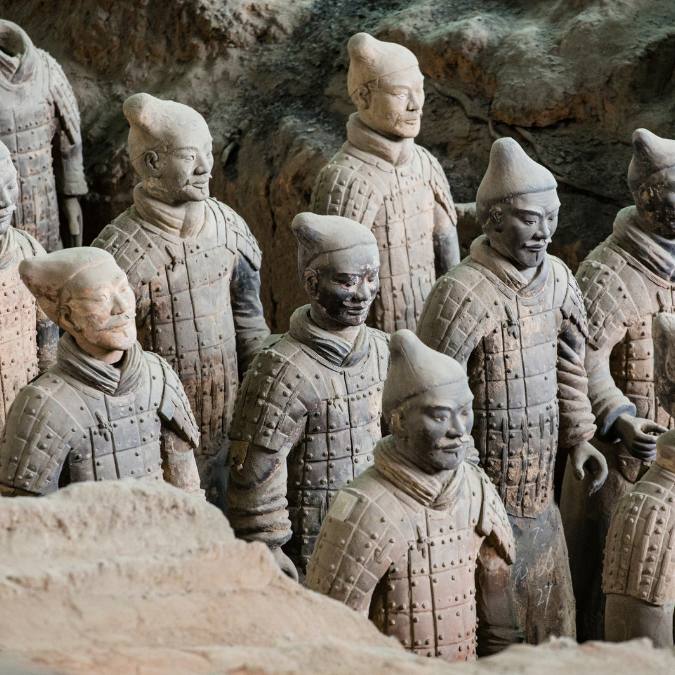
When we think of the world’s great ancient civilizations, Egypt, Mesopotamia, and the Indus Valley often come to mind. Yet China stands as one of the oldest and most enduring cradles of civilization, shaping not only East Asia but also human history as a whole. Its roots stretch back over 4,000 years, beginning with legendary rulers and continuing with powerful dynasties, technological innovations, and influential philosophies.
This article explores Ancient China, focusing on the Xia, Shang, and Zhou dynasties, their technological contributions (bronze, writing, silk), the birth of Confucianism and Taoism, and the social and military structures that held these empires together.
The Cradle of Chinese Civilization 🏞️
The early history of China is a mix of legend, archaeology, and historical records. Unlike some civilizations that disappeared, China developed continuously, maintaining a cultural identity that has lasted thousands of years. The earliest dynasties laid the foundations for Chinese governance, philosophy, and technology.
By exploring the Xia, Shang, and Zhou dynasties, we gain a clearer understanding of how myth became history, how technology shaped society, and how ideas born in antiquity still influence China and the world today.
The Xia Dynasty (c. 2070–1600 BCE) 🏯
The Xia Dynasty is traditionally considered the first dynasty of China, though it remains partly legendary because concrete archaeological evidence is scarce. Much of what we know comes from ancient texts like the Records of the Grand Historian (Shiji) by Sima Qian.
Characteristics of the Xia Dynasty
- Believed to have been founded by Yu the Great, famed for controlling devastating floods through large-scale engineering projects.
- Considered the transition from Neolithic cultures (like the Longshan culture) to organized statehood.
- Archaeological discoveries at Erlitou in Henan province may be linked to the Xia, showing evidence of palaces, bronze casting, and social hierarchy.
While historians debate its historicity, the Xia Dynasty represents the mythical roots of Chinese civilization, marking the shift from tribal confederations to dynastic rule.
The Shang Dynasty (c. 1600–1046 BCE) 🔥⚒️
The Shang Dynasty is the first Chinese dynasty supported by firm archaeological evidence, thanks to discoveries of oracle bones and large bronze works.
Achievements of the Shang Dynasty
- Bronze Technology: The Shang perfected bronze casting, creating weapons, ritual vessels, and tools. These items symbolized power and were used in ceremonies honoring ancestors.
- Writing System: The earliest form of Chinese writing appears on oracle bones (turtle shells and animal bones used for divination). This script is a direct ancestor of modern Chinese characters.
- Urban Centers: The capital at Anyang featured palaces, temples, and royal tombs, including elaborate burials filled with jade, bronze, and human sacrifices.
- Religion and Ancestor Worship: The Shang believed in a supreme deity called Shangdi, but ancestors also played a crucial role in guiding the living.
- Military Power: Shang armies relied on bronze weapons, chariots, and well-organized units, making them formidable in warfare.
The Shang Dynasty laid the foundation for Chinese statecraft, religion, and technology. Its advancements in metallurgy and writing made it a true Bronze Age civilization.
The Zhou Dynasty (c. 1046–256 BCE) ⚔️📜
The Zhou Dynasty succeeded the Shang and became one of the most influential dynasties in Chinese history. It is divided into two major periods:
- Western Zhou (1046–771 BCE) – a time of relative stability.
- Eastern Zhou (770–256 BCE) – marked by political fragmentation but also great intellectual flourishing.
Key Features of the Zhou Dynasty
- Mandate of Heaven: The Zhou justified their conquest of the Shang by introducing the idea that heaven grants rulers the right to govern. If a king failed morally, heaven would withdraw its support. This concept shaped Chinese political thought for millennia.
- Feudal System: Land was distributed among nobles who pledged loyalty to the king, similar to feudalism in medieval Europe.
- Technological Growth: Iron tools began to replace bronze, boosting agriculture and warfare.
- Philosophical Golden Age: During the Eastern Zhou, especially the Spring and Autumn and Warring States periods, major schools of thought emerged, including Confucianism and Taoism.
- Military Advances: The Zhou developed large armies, crossbows, cavalry, and siege tactics, making warfare increasingly sophisticated.
Despite political instability in its later years, the Zhou era became a cultural and philosophical turning point in Chinese history.
Technological Contributions of Ancient China 🛠️✨
Ancient China was a hub of technological innovation, much of it emerging during the Xia, Shang, and Zhou dynasties.
Bronze Age Innovations
- Bronze weapons (daggers, spears, arrowheads).
- Ritual vessels decorated with intricate motifs.
- Tools that improved farming efficiency.
Writing System
- Oracle bones provided the first written records in China.
- Early characters combined pictographs and ideographs.
- This script evolved into the logographic system still in use today.
Silk Production 🐛
- By the Shang and Zhou periods, the Chinese had mastered sericulture (silk farming).
- Silk garments became symbols of status and wealth.
- The later Silk Road would spread this prized material worldwide.
These innovations highlight how the early Chinese dynasties were not only warrior states but also pioneers of culture and technology.
Ancient Chinese Philosophy: Confucianism and Taoism 🧘📖
The Zhou period, particularly during the Warring States era, gave rise to China’s two most enduring philosophies: Confucianism and Taoism.
Confucianism (Confucius, 551–479 BCE)
- Focused on ethics, morality, and social harmony.
- Emphasized filial piety (respect for parents and ancestors).
- Advocated for just rulers and virtuous officials.
- Believed that a well-ordered society depended on proper relationships (father-son, ruler-subject, husband-wife).
Taoism (Laozi, 6th century BCE, attributed)
- Centered on living in harmony with the Dao (the Way).
- Valued simplicity, nature, and inner peace.
- Rejected rigid social hierarchies in favor of balance and spontaneity.
- Inspired practices like meditation, alchemy, and traditional Chinese medicine.
Together, these philosophies created a balance: Confucianism focused on society and order, while Taoism offered spiritual depth and individual freedom. Both continue to influence Chinese culture today.
Social and Military Organization in Ancient China ⚔️👥
Social Structure
Ancient Chinese society was hierarchical:
- King/Emperor – held divine authority under the Mandate of Heaven.
- Nobles and Aristocrats – controlled land and served as warriors.
- Artisans and Merchants – contributed to the economy with crafts and trade.
- Peasants – the majority, responsible for farming and sustaining society.
- Slaves and Servants – at the bottom of the hierarchy.
Military Power
- Armies consisted of nobles, chariots, and later professional soldiers.
- The Shang relied heavily on bronze weaponry and chariots.
- By the Zhou period, iron weapons, cavalry, and crossbows transformed warfare.
- Large-scale conflicts during the Warring States period set the stage for China’s eventual unification under the Qin Dynasty.
Military strength not only defended territories but also expanded them, while social organization ensured that resources were managed effectively.
Legacy of the Xia, Shang, and Zhou Dynasties 🌏
These three dynasties established the foundations of Chinese civilization:
- Xia: Mythical beginnings and flood control.
- Shang: Bronze, writing, ancestor worship, and strong kingship.
- Zhou: Mandate of Heaven, feudalism, philosophy, and iron technology.
They shaped a civilization that would influence East Asia for millennia, leaving behind a legacy of innovation, philosophy, and governance.
Conclusion 📝
The story of Ancient China is one of resilience, creativity, and profound cultural impact. From the legendary Xia Dynasty to the philosophical golden age of the Zhou, these early dynasties forged a society that combined technological brilliance with deep spiritual thought.
The mastery of bronze, the invention of writing, and the development of silk reflected a civilization far ahead of its time. Meanwhile, the rise of Confucianism and Taoism gave humanity enduring wisdom on ethics, harmony, and the meaning of life.
Understanding Ancient China means appreciating one of history’s most enduring civilizations, whose legacy still shapes the modern world.
Sources 📚
- Loewe, Michael & Shaughnessy, Edward L. The Cambridge History of Ancient China. Cambridge University Press, 1999.
- Keay, John. China: A History. HarperCollins, 2009.
- Fairbank, John King & Goldman, Merle. China: A New History. Belknap Press, 2006.
- National Geographic. “Ancient China.”
- Encyclopaedia Britannica. “Xia, Shang, and Zhou Dynasties.”

